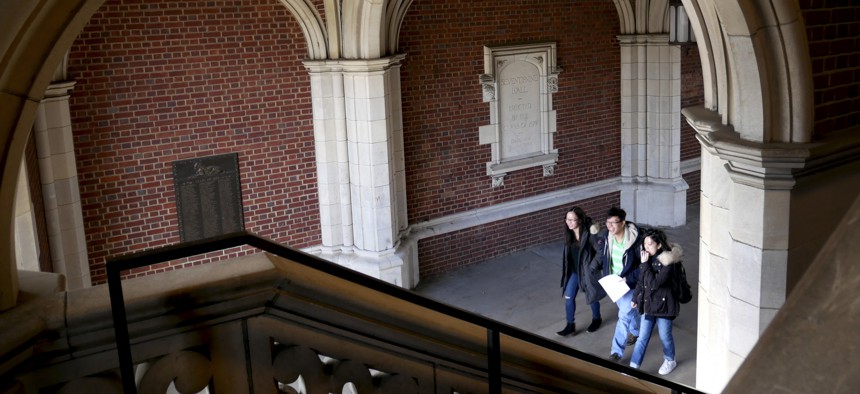Community-College Students Succeed at Elite Schools—When They’re Admitted

People walk through one of the famous arches of Princeton University in Princeton, N.J., April 5, 2018. AP Photo

Connecting state and local government leaders
A new report finds that these students graduate from selective colleges at higher rates than first-time freshmen.
There’s a perception, flawed as it may be, that college admissions are a zero-sum game. One student gets in, another loses out. That perception is even more acute when it comes to selective institutions, where the seats are few and the applications from qualified students are plenty.
Once students get into such selective schools—with all of the money, prestige, and support that comes with them—they tend to perform well, stay in school, and graduate. According to a new report from the Jack Kent Cooke Foundation, that is particularly true of students who transfer from community colleges. The report, released Tuesday, finds that graduation rates of community-college transfers meet or exceed those of students who enroll at selective institutions as first-time freshman. Community-college transfers also graduate at higher rates than students who transfer from other four-year colleges.
But as Jennifer Glynn, the director of research at the foundation, put it, “There is an underrepresentation issue.” Selective colleges don’t enroll a lot of transfer students. Princeton, for example, recently moved to reinstate its transfer program. The institution hadn’t accepted transfers since 1990. The university then offered admission to just 13 transfer students. That low number is not uncommon at private, elite schools like Princeton.
According to the report, 35 public selective colleges together “enroll 4 times as many transfer students as the 140 private selective institutions.” That’s likely due in part to the low overall enrollment at private institutions, alongside a commitment to a “traditional” college experience, one in which a student graduates from high school and goes directly to live on campus. What makes a traditional experience is changing though. These days, the typical student is likely older, or lives off campus, or has a full-time job, or is going to school part-time, or has a child, or has some combination of any of those traits. And more often, students are starting their higher education at community colleges. In fact, more than 40 percent of all U.S. undergraduates attend community colleges.
Of those community-college students who want to transfer to a four-year college, there are many who might be a good fit for highly selective institutions. (Of course, they could also succeed at a wide range of schools.) However, community-college transfer students make up just 15 percent of all newly enrolling bachelor’s-degree students nationwide, and only about 5 percent of enrolling undergraduates at the top 100 schools.
For the students who do ultimately transfer to selective colleges, it’s not that there are just a few shining stars skewing the data—say, a couple of community colleges launching dozens and dozens of students to selective institutions. The greatness is everywhere. “Fully 84 percent of the nation’s two-year institutions transferred at least one student to a selective four-year institution in fall 2016,” the report says.
Admissions officers are starting to notice, as evidenced by a 2018 National Association for College Admission Counseling report that found that roughly 90 percent of admissions counselors regard transfers as moderately or considerably important to enrollment goals. But it will likely take considerable gumption to push selective colleges to enroll more transfer students, if only because the status quo is so baked in to admissions officers’ mind-set. Foundations such as Jack Kent Cooke have been working with colleges to help them enroll and fund transfer students, and organizations such as the American Talent Initiative have been pushing to get more community-college students into these schools. Even still, the mighty few who have large endowments, a working business model, and few empty seats may not feel compelled to enroll more transfer students.
Still, this report shows that if admissions officers will accept them, community-college students are prepared to succeed at any college—even the most selective.
Adam Harris is a Staff Writer at The Atlantic, which originally published this article.

NEXT STORY: Signs of Rising Support From Governors For Legal Pot, As AG Nominee Vows Not to Crack Down




